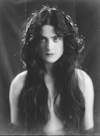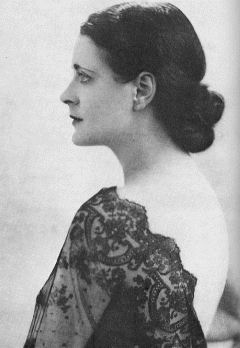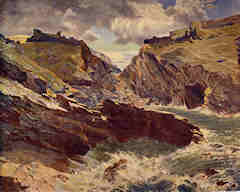Copyright
1915
- The Princess's Rose Garden
- 161. Nocturne, for piano.
- In a Vodka Shop
- 162. For piano, dedicated in manuscript "To Tania" (= Harriet Cohen) and on the printed score "To Myra Hess". (An example of eating your cake and having it?) Orchestrated 1919 as the third movement of the Russian Suite (GP215).
- The Maiden with the Daffodil
-
163. "An idyll", for piano.

"Tania" (Cohen) First performed by Myra Hess, but the maiden in question was Harriet Cohen. (Pictured right, trying not to look like the painting of Queen Maev by J C Leyendecker.) - Nympholept
- 164. Orchestral tone-poem based on piano original of 1912 (GP148) and revised in 1933 (GP333). "The title of this short tone-poem comes from Swinburne [his poem A Nympholept], and the quotation [Enter these enchanted woods / You who dare…] from [George] Meredith's The Woods of Westermain. Both poems derive from the same central idea - that of a perilous pagan enchantment haunting the sunlit midsummer forest." (A.B.) Or, to put it another way, "The tale telleth how one walking at summer-dawn in haunting woods was beguiled by the nymphs, and, meshed in their shining and perilous dances, was rapt away for ever into the sunlight life of the wild-wood" (A.B.). In yet other words, the sylvan equivalent of the maritime Garden of Fand.
- Legend
- 165. One of many, this for violin and piano in one movement.
- Violin Sonata No. 1
- 166. Second version of the Violin Sonata of 1910 (GP124), with 2nd and 3rd movements entirely rewritten. Further revised 1920 (GP236) and 1945 (GP361).
- Quintet in G minor
- 167. A substantial and important work for piano and strings.
- Apple-Blossom Time
- 168. For piano, to S. H. Braithwaite.
- Sleepy-Head
- 169. For piano, "To Elsita" - the only composition Bax ever dedicated to his wife.
- Red Owen
- 170. Unfinished opera. Text: "Dermot O'Byrne" (= A.B.). "A folk comedy rather in the manner of J M Synge, based on the Irish tale The Twisting of the Rope (A.B.). (Not so much unfinished as barely started: only a few musical sketches survive, though the libretto was published in 1919.)
- Violin Sonata No. 2
- 171. For violin and piano. Curiously structured in four movements, the second subtitled "The Grey Dancer in the Twilight". Revised 1921.
- A Mountain Mood
- 172. Melody and Variations, for piano. One of my favourites - I greatly miss my old 78-rpm disc of Harriet Cohen's rendering, which unfortunately broke in transit.
- Winter Waters
- 173. Subtitled "Tragic Landscape", and definitely on the chilly side.
1916
- The Garden of Fand
- 175. Orchestral tone poem

How not to design an LP sleeve - Bax's favourite, and the last he heard performed before he died. Fand is the goddess of the sea in Irish legend, and her garden lies beneath the waves, to which she lures unwary travellers with siren-like song, dance and revelry. On a similar theme, see also Moy Mell. - Dream in Exile
- 176. Intermezzo for piano. To Tobias Matthay.
- Nereid
- 177. Piano solo. "He had vaguely in mind some sort of water nymph of Greek mythological times", wrote Harriet Cohen. But then, he often did.
- Elegiac Trio
- 178. For flute, viola and harp, a combination probably inspired by Debussy's trio of 1915.
- In Memoriam
- 179. Musically unrelated to the sextet In Memoriam (1917), this one is specifically in memory of Pádraig Pearse, who was executed after the Easter Uprising. Colin Scott-Sutherland writes: "In A Dublin Ballad and other poems, published in a limited edition of 425 copies by the Candle Press, Dublin, in 1918, Bax sang the heroes of the revolt - and found himself in conflict with the English censor by whom the book was banned as subversive (a strange position for the future guardian of English musical respectability to find himself in)". It includes a theme later associated with Mr Brownlow in the film music for David Lean's film version of Oliver Twist. The full score (edited by GP) was published in 2013 by Richard Frazier Music". In Memoriam was played at Graham's funeral in July 2021.
- Moy Mell (The Happy Plain)
-
180. "An Irish Tone-Poem", for two pianos. I cherish a 78 rpm recording of
this delightful and hypnotic piece played by Bartlett and Robertson, despite
their race to get it on to two sides in less than 8 minutes. Bax comments
on it thus: "Moy Mell (properly Magh Mell) means 'The Pleasant Plain', one
of the three ideas connected with the ancient Irish conception of the
'Happy Otherworld' or Pagan paradise. The other two are the enchanted island
in the Atlantic (to which St. Brendan and many others are said to have adventured
in their coracles) and the faery world of the Hollow Hill. I have treated both of
these in two orchestral works,
The Garden of Fand and
In the Faery Hills.
There is no definite story attached to Moy Mell apart from this poetic
basis." (A.B.)
Graham Parlett adds: "Just came across this, from the South Coast Times and Wollongong Argus, 19 September 1947: "Their first item was 'Moy Mell' by the ultra-modernist Arnold Bax..." - Ballad
- 181. Short piece for violin and piano. "I believe it is rather good - it's a wild stormy thing" (A.B.) Revised 1921.
- I know Myself no more, my Child
- 182. For voice and piano, text attributed to "Æ" (George Russell). Score untraced.
- A Leader
- 183. Baritone and piano. Text: "Æ" (George Russell). Dedication: "In memory of certain Irish patriots."
- O Mistress Mine
- 184. Text: Shakespeare. Parting 185. Text: "Æ" (George Russell). Colin Scott-Sutherland points out a melodic connection between this song and the Symphonic Variations of 1918.
1917
- The Splendour falls on Castle-Walls
- 186. Text: Tennyson. Re-done as one of Three Songs (GP325, 1933).
- Scherzo
- 187. For orchestra; revised 1933.
- From Dusk till Dawn
- 188. Ballet in one act, commissioned by Mrs Christopher Lowther, concerning the nocturnal activities of Dresden china figures.
- Go, Lovely Rose
- 189. Text: Edmund Waller. (Score untraced.)
- In Memoriam (1916) [aka Irish Elegy]
-
190. Sextet for cor anglais,

Harriet Cohen's
favourite portrait photo harp and string quartet. Distinct from the orchestral In Memoriam of 1916, and in fact first performed under the title Irish Elegy. - November Woods
- 191. Orchestral tone-poem. "The whole piece and its origins are connected with certain rather troublous experiences I was going through myself at the time... The middle part may be taken as a dream of happier days, such as sometimes come in the intervals of stress either physical or mental" (A.B.). This masterpiece was in fact conceived when Bax was caught in a storm in beech woods near Amersham station after a tryst with pianist Harriet Cohen [pictured, right], for whom he was contemplating leaving his wife and children. The principal theme was also used in his Second Violin Sonata.
1918
- I have House and Land in Kent - Jack and Jone - The Maid and the Miller - O Dear! What can the Matter be? - Trois Enfantines
- 192 - 196. Folk-song arrangements for soprano (Raymonde Collignon) and piano, from the Répertoire Collignon.
- Variations sur "Cadet-Rousselle"
- 197. Arrangement of French folk-song with Frank Bridge, Eugene Goossens and John Ireland, "To our good friend Edwin Evans, who suggested this collaboration".
- Folk-Tale
- 198. Short piece for cello and piano, subtitled (but not in Bax's handwriting) Conte Populaire.
- String Quartet No. 1 in G major
- 199. An unusually light and jolly first movement precedes a deep and pensive slow movement, followed by a jig-like rondo incorporating a beautiful quasi-Irish folk tune reminiscent of Ban Cnuic Éirann Óg (which also appears in Christmas Eve on the Mountains).
- Dance Prelude and Lament of the Swan-Princess
- 200. Orchestration of piano pieces by Anatol Liadov.
- Far in a Western Brookland
- 201. For medium voice and piano. Text: A E Housman, A Shropshire Lad.
- The Frog-Skin
- 202. Ballet. Lost, possibly never completed.
- Green Grow the Rashes O!
- 203. "A Character Sketch". Text: Robert Burns.
- Midsummer
- 204. Text attributed to Clifford Bax, though he published no poem of this title. Score untraced.
- On a May Evening
- 205. Piano solo. (Quite nice, but goes on a bit.)
- A Romance
- 206. Piano solo based on the theme Bax always associated with Harriet Cohen, which first appeared in November Woods and occurs again the slow movement of the Fourth Symphony.
- When I was One-and-Twenty
- 207. Text: A E Housman, A Shropshire Lad.
- Youth
- 208. Text: Clifford Bax.
- Festival Overture
- 209. Revision of GP134 (1911).
- Symphonic Variations
- 210. A powerful work for piano and orchestra written for Harriet Cohen (whose hands were really too small for Bax's gigantic requirements - she was unable to strike a ninth in either). Lasting nearly 50 minutes, it is in two briefly separated halves, each consisting of connected movements whose titles suggest the exploits of some unnamed legendary hero. It consists of an Introduction, which actually introduces two themes that seem to play equally prominent parts throughout - followed by sections labelled: Youth - Nocturne - Strife - The Temple - Scherzo (Play) - Intermezzo (Enchantment) - Triumph. There is an excellent analysis of this work in Colin Scott-Sutherland's book.
- Scherzo
- 212. "In the years 1917-1918 Edwin Evans, on behalf of the Aeolian Company, approached well-known composers of the day, including Stravinsky, Bax, Goossens, Grainger and Bowen, for a series of pianola rolls" (Monica Watson, in York Bowen: A Centenary Tribute, London 1984).) This truncated arrangement of the Scherzo of 1913 was issued on pianola by the Aeolian Co. in 1920.
1919
- Tintagel
-
213. Orchestral tone poem

Tintagel (unsourced Victorian painting) with Arthurian legendary references, including a quotation from Wagner's Tristan and Isolde. Bax's best-known work was conceived on a six-week holiday in Cornwall ostensibly with his family but in fact with Harriet Cohen installed nearby. - Quintet
- 214. For harp and strings, in one movement.
- Russian Suite
- 215. (1) Gopak (National Dance), (2) Nocturne (May Night in the Ukraine), (3) In a Vodka Shop. Commissioned to serve as "symphonic interludes" between Diaghilev ballets at the Alhambra Theatre. Only two were used. The Nocturne, left in piano score, has been orchestrated by Graham Parlett.
- Whirligig
- 216. Piano solo dedicated to Irene Scharrer.
- Piano Sonata No. 2
- 217. In one movement, largely dark and brooding, but with a contrasting heroic section marked "brazen and glittering", a mysterious middle section marked "slow and concentrated", and a calm, semplice ending. Harriet Cohen described it (for the article on Bax by Julian Herbage in British Music of Our Time, 1946) as "again an epic conception, this time taking the form of a contest between a legendary hero and the powers of darkness. It has been described as The Battle with the Loathly Worm". Given Bax's complex personality, however, one might feel the warring elements sound less like George and the Dragon than Jekyll and Hyde. The sonata was revised between its first and second performances (Nov 1919 - June 1920).
- The Slave Girl
- 218. Piano solo, dedicated to "Madame Tamara Karsavina". Published 1919, composed 1914.
- What the Minstrel told Us
- 219. Piano solo, subtitled "A ballad" (in case anyone thought they were in for a dirty joke).